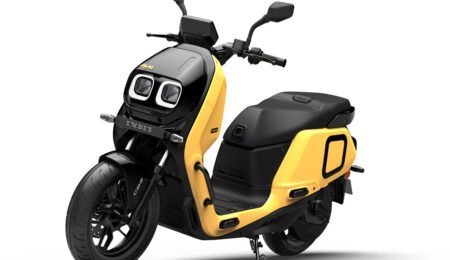A prototype that serves as a development base for future British productions
177 hp, 217 km/h, 220 kg, 161 km range

For many months, Triumph has been present on multiple projects, whether in terms of the renewal of its production models or the preparation of off-road motorcycles. But if there is one that commands more attention, it is that of the TE-1 electric motorcycle.
Initiated in the spring of 2019, the TE-1 project brought together several players specializing in different sectors to design a high-performance electric motorcycle in its entirety. Around Triumph, we found the British innovation agency Innovate UK, Williams Advanced Engineering, Integral Power-train Ltd and WMD at the University of Warwick.
Since the announcement of this project, the Hinckley manufacturer has regularly kept us informed of the steps taken, whether with the validation of the power unit or at the start of the year with the presentation of the functional prototype.
Dynamic tests
Since then, the electric roadster has been tested for many months. First on the bench to configure the acceleration, the power curve, the torque level, the battery consumption, the driving modes, the entire software part or the liquid cooling system.

Dynamic tests of the electric roadster
Following this, the bike was taken to the circuit to validate the dynamic performance, both in terms of acceleration and handling, braking and energy regeneration. To do this, the brand was able to count on the presence of Brandon Paasch, double winner of the Daytona 200.
Visually, the prototype retains this fairly typical look of Triumph sports roadsters with its aluminum perimeter frame or its double front headlight. The brand explains that the TE-1 combines the ergonomics and sensations of a SpeedTriple with the more compact size of a Street Triple.

Triumph Te-1 electric prototype
Integral powertrain
On the performance side, the permanent magnet electric motor is quite efficient since it manages to deliver up to 177 horsepower of maximum power to reach a top speed of 217 km/h and achieve the 0 to 100 km/h in 3, 7 seconds. This power is delivered linearly thanks to two transmission ratios, but without a gearbox. In addition to a reverse gear and an aid for manoeuvres, the roadster is equipped with a final belt drive which Triumph assures that it can last at least 96,000 km.

The TE-1 reaches a top speed of 217 km/h
Sound being an aspect on which Triumph has always been demanding, the TE-1 is no exception to the rule and the manufacturer has paid attention so that the roadster delivers a fairly recognizable turbine noise.
Battery and technologies
The battery pack, which serves as the structural element of the chassis, is made up of Samsung NMC cells for a total capacity of 15 kWh. According to the WMTC protocol, which translates mixed conditions similar to those encountered in everyday use, the range reaches 161 km. The roadster is also equipped with a Chademo port allowing it to be recharged with direct current in 20 minutes from 0 to 80%.

20 minutes to charge the battery up to 80%
All this is cooled by a dual liquid system, one for the battery, the other for the motor, to ensure constant performance. The motorcycle has also been developed with a whole battery of assistance in addition to energy regeneration during braking and reverse, it is accompanied by four engine modes, anti-wheelie, ABS and cornering traction control. The set manages to maintain a reasonable weight for an electric motorcycle of this caliber since the TE-1 claims 220 kg on the scale.

The cycle part opts for high-end equipment
However, this is not a version that will be mass-produced, but a pure prototype. On the other hand, Triumph does develop series electric models and ensures that this TE-1 is a good indication of what to expect since it will serve as a working basis for future productions.

This prototype will serve as a development base for future Triumph electric motorcycles
On the other hand, several technical modifications are likely to be integrated into the production models, in particular at the level of the charging system which could be done more on a CCS port more frequent in Europe and compatible with alternating current.

The manufacturer announces 161 km of WMTC autonomy
The Hinckley brand did not wish to give a release date for its first electric model production. Since this model production has just begun.
For more details about Triumph





